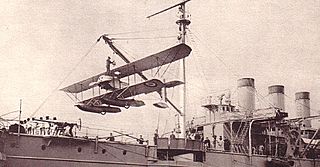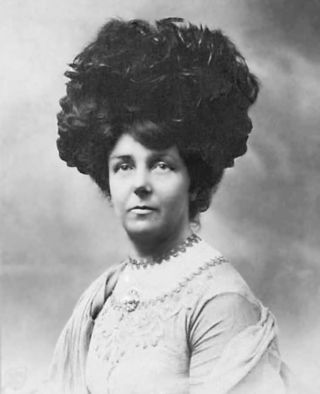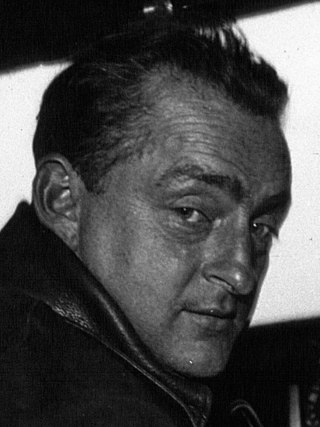Related Research Articles

Henri Farman was a British-French aviator and aircraft designer and manufacturer with his brother Maurice Farman. Before dedicating himself to aviation he gained fame as a sportsman, specifically in cycling and motor racing. Henri took French nationality in 1937.

The Société des Avions Caudron was a French aircraft company founded in 1909 as the Association Aéroplanes Caudron Frères by brothers Gaston and René Caudron. It was one of the earliest aircraft manufacturers in France and produced planes for the military in both World War I and World War II. From 1933 onwards, it was a subsidiary of Renault.

French Naval Aviation is the naval air arm of the French Navy. The long-form official designation is Force maritime de l'aéronautique navale. Born as a fusion of aircraft carrier squadrons and the naval patrol air force, the Aéronavale was created in 1912. The force is under the command of a flag officer officially titled Admiral of Naval Aviation (ALAVIA) with his headquarters at Toulon naval base. It has a strength of around 6,800 military and civilian personnel. It operates from four airbases in Metropolitan France and several detachments in foreign countries or French overseas territories. Carrier-borne pilots of the French Navy do their initial training at Salon-de-Provence Air Base after which they undergo their carrier qualification with the US Navy.

A trimotor is a propeller-driven aircraft powered by three internal combustion engines, characteristically one on the nose and one on each wing. A compromise between complexity and safety, such a configuration was typically a result of the limited power of the engines available to the designer. Many trimotors were designed and built in the 1920s and 1930s as the most effective means of maximizing payload.

The Free French Air Forces were the air arm of the Free French Forces in the Second World War, created by Charles de Gaulle in 1940. The designation ceased to exist in 1943 when the Free French Forces merged with General Giraud's forces. The name was still in common use however, until the liberation of France in 1944, when they became the French Air Army. Martial Henri Valin commanded them from 1941 to 1944, then stayed on to command the Air Army.

Hilda Beatrice Hewlett was an early aviator and aviation entrepreneur. She was the first British woman to earn a pilot's licence. She founded and ran two related businesses: the first flying school in the United Kingdom, and a successful aircraft manufacturing business which produced more than 800 aeroplanes and employed up to 700 people. She later emigrated to New Zealand.

Between 1920 and 1951 the Société des Moteurs Salmson in France developed and built a series of widely used air-cooled aircraft engines.
Hewlett & Blondeau was a manufacturer of aeroplanes and other equipment based in Leagrave, Luton, England which produced more than 800 aeroplanes and employed up to 700 people.

The Italian Corpo Aeronautico Militare was formed as part of the Regio Esercito on 7 January 1915, incorporating the Aviators Flights Battalion (airplanes), the Specialists Battalion (airships) and the Ballonists Battalion. Prior to World War I, Italy had pioneered military aviation in the Italo-Turkish War during 1911–1912. Its army also contained one of the world's foremost theorists about the future of military aviation, Giulio Douhet; Douhet also had a practical side, as he was largely responsible for the development of Italy's Caproni bombers starting in 1913. Italy also had the advantage of a delayed entry into World War I, not starting the fight until 24 May 1915, but took no advantage of it so far as aviation was concerned.
Compagnie des messageries aériennes was a pioneering French airline which was in operation from 1919–23, when it was merged with Grands Express Aériens to form Air Union.
Blondeau is a French surname. Notable people with the surname include:

Commandant Maurice Albert Alfred Jean Arnoux was a French World War I flying ace credited with five aerial victories. After the end of the First World War, he continued his aviation career during the 1930s as an air racer and aviation record setter until the Second World War. He returned to flying fighter planes during the early days of World War II, but was killed in action in 1940.

Maggiore Sebastiano Bedendo was a World War I flying ace credited with five aerial victories. After completing his education postwar, he rejoined Italian military aviation. He set several world aviation flying records with a Nuvoli N.5 monoplane before dying in an air crash.

The Salmson water-cooled aero-engines, produced in France by Société des Moteurs Salmson from 1908 until 1920, were a series of pioneering aero-engines: unusually combining water-cooling with the radial arrangement of their cylinders.
The Renault 4P, also called the Renault Bengali Junior, was a series of air-cooled 4-cylinder inverted inline aero engines designed and built in France from 1927, which produced from 95 hp (71 kW) to 150 hp (110 kW).

The Hydroaéroplane Caudron-Fabre, (Caudron-Fabre), was a French amphibious seaplane that competed in the 1912 Monaco event. It was one of the first true amphibians, able to take-off from water and touch down on land.
The Vickers Boxkite refers to three aircraft built by Hewlett & Blondeau and a single similar aircraft actually built by Vickers was created by Vickers Aviation. Originally, Vickers used their own monoplanes at their flying school at Brooklands. In late 1912 the school bought three Farman-type aircraft from Hewlett & Blondeau, who also had a flying school at Brooklands. These three aircraft were modified to become the Vickers Boxkite. The Vickers constructors numbers given to these aircraft were No. 19, 20, and 21.
References
- ↑ History of Hewlett and Blondeau [ permanent dead link ]
- ↑ "No. 43607". The London Gazette . 23 March 1965. p. 3031.